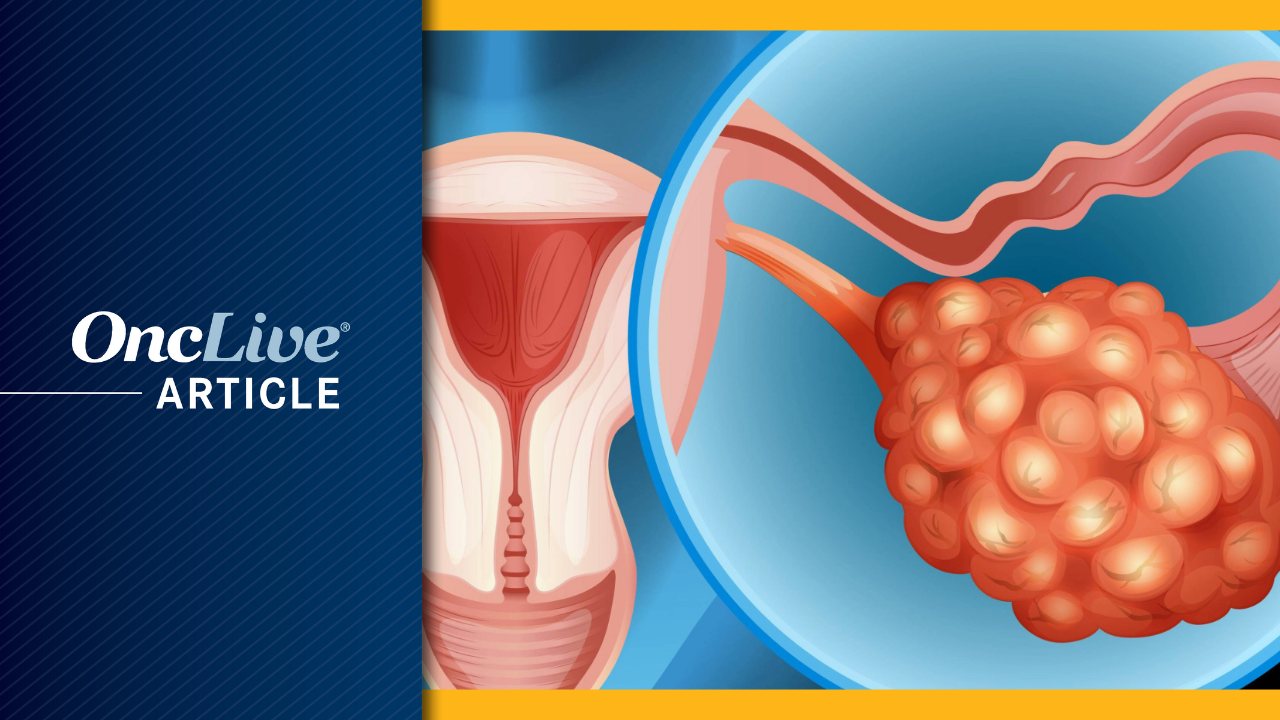Palbociclib (Ibrance) monotherapy displayed modest activity for the treatment of unselected patients with ovarian cancer. Nevertheless, treatment with a CDk4/6 inhibitor showed promising efficacy in patients with low-grade serous ovarian cancer (LGSOC), according to data from a phase 2 study (NCT01536743) published in the International Journal of Gynecological Cancer.1
Among all efficacy-evaluable patients (n = 40), the biochemical response rate was 8.3% (95% CI, 2.2%-23.6%) and the objective response rate (ORR) per CA-125 and/or RECIST 1.1 criteria was 10.5% (95% CI, 3.4%-25.7%). The median progression-free survival (PFS) was 3.3 months (range, 2.8-5.0); the 6- and 12-month PFS rates were 25% (95% CI, 14.6%-42.8%) and 7.5% (95% CI, 2.5%-22.2%), respectively.
At a median follow-up of 26.7 months, the median PFS among patients with LGSOC (n = 12) was 26.7 months (95% CI, 13.4-not applicable). The 6- and 12-month PFS rates were 83.3% (95% CI, 64.7%-100.0%) and 75.0% (95% CI, 54.1%-100.0%), respectively. Patients in this observational cohort received palbociclib or ribociclib (Kisqali) outside of the phase 2 study.
Palbociclib Monotherapy in Patients With Ovarian Cancer: Key Takeaways
- Palbociclib displayed a biochemical response rate of 8.3% (95% CI, 2.2%-23.6%) and an objective response rate of 10.5% (95% CI, 3.4%-25.7%) in an unselected population of patients with ovarian cancer.
- The median progression-free survival (PFS) was 3.3 months (range, 2.8-5.0); the 6- and 12-month PFS rates were 25% (95% CI, 14.6%-42.8%) and 7.5% (95% CI, 2.5%-22.2%), respectively.
- However, treatment with a CDK4/6 inhibitor led to a median PFS of 26.7 months (95% CI, 13.4-not applicable), with 6- and 12-month PFS rates of 83.3% (95% CI, 64.7%-100.0%) and 75.0% (95% CI, 54.1%-100.0%), respectively, in an observational cohort of patients with low-grade serous ovarian cancer.
“Palbociclib demonstrated only modest clinical activity in unselected patients with ovarian cancer. However, CDK4/6 inhibition showed promising clinical activity in LGSOC, warranting further study in this subtype,” lead study author Gottfried E. Konecny, MD, the lead clinician for gynecologic oncology in the Department of Medicine at the University of California, Los Angeles Health in Los Angeles, California, and his coauthors wrote in the publication.
What Were the Key Design and Baseline Characteristics of the Phase 2 Study?
The phase 2 study enrolled patients who were at least 21 years old with recurrent histologically confirmed ovarian epithelial, including fallopian tube and primary peritoneal, carcinoma with Rb proficiency and low expression of p16.1,2 To be eligible for the study, patients needed to have an ECOG performance status of 0 or 1, adequate organ and bone marrow function, adequate coagulation parameters, and disease progression following 3 or fewer lines of chemotherapy for recurrent disease.
All patients received palbociclib at 125 mg daily for 21 days in a 28-day cycle.1 Treatment continued until radiologic progression, CA125 progression per Gynecologic Cancer InterGroup criteria, or unacceptable toxicity. Antihormonal therapy with an aromatase inhibitor (AI) was permitted at the discretion of the treating provider in the setting of positive hormone receptor status.
The primary end point was biochemical response rate. Secondary end points included ORR, clinical benefit rate, and PFS.
At baseline, the median age in the phase 2 cohort was 61 years (range, 42-78). Most patients had stage IIIC disease at diagnosis (87.5%), serous disease (85%), histologic grade G3 disease (90%), elevated CA-125 status (90%), received at least 3 prior therapies (62.5%), had BRCA wild-type disease (78.4%), had estrogen receptor (ER)–positive disease (90%), and received no concurrent AI inhibitor therapy (67.5%).
In the observational cohort, the median age at baseline was 58 (range, 32-69), and 50% of patients had stage IIIC disease at baseline. All patients in this cohort had serous and BRCA wild-type disease, as well as ER-positive disease. Most patients had histologic grade G1 disease (92%), elevated CA-125 levels (58%), and received a concurrent AI inhibitor (83.3%).
What Were the Key Safety Results and the Additional Efficacy Data?
In terms of safety, no new signals were observed. The most common any-grade adverse effects included neutropenia (82.5%), anemia (65.0%), asthenia/fatigue (57.5%), nausea (45%), thrombocytopenia (40%), and diarrhea (27.5%). The most common grade 3 and 4 AEs included neutropenia (40%), thrombocytopenia (10%), and anemia (7.5%).
No fatal AEs were reported. Fifteen percent of patients experienced AEs leading to a dose reduction of palbociclib from 125 mg to 100 mg daily.
Two patients with LGSOC in the prospective clinical trial achieved long-term disease stabilization lasting 37 months and 9 months. Additionally, 1 patient with recurrent endometrioid ovarian cancer harboring a CDKN2A deletion and discontinued hormone replacement therapy before starting palbociclib and anastrozole experienced a complete response.
“This study, in combination with results from other recent phase 2 trials, provides additional evidence regarding the efficacy of CDK4/6 inhibitors for patients with LGSOC,” Konecny and his coauthors wrote in their conclusion. “However, given the small sample sizes of the current and previous studies, larger, higher-powered studies with a control arm are needed to fully elucidate the benefit of these drugs for patients with LGSOC.”
References
- Konecny GE, Davidson TM, Lebreton CL, et al. Phase II study of the efficacy and safety of palbociclib in patients with recurrent ovarian cancer. Int J Gynecol Cancer. 2025;35(10):102028. doi:10.1016/j.ijgc.2025.102028
- A open label study of the efficacy and safety of PD0332991 a selective inhibitor of the cyclin dependent kinases 4 and 6 in patients with recurrent ovarian cancer demonstrating Rb-proficiency and low p16 expression. ClinicalTrials.gov. Updated June 5, 2020. Accessed October 6, 2025. https://clinicaltrials.gov/study/NCT01536743
